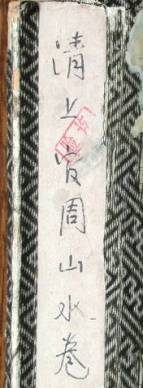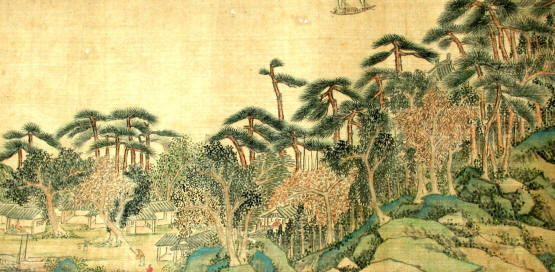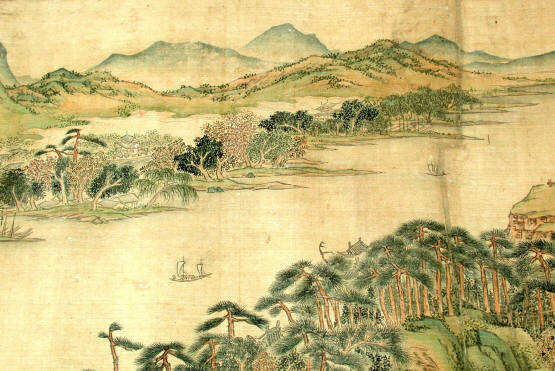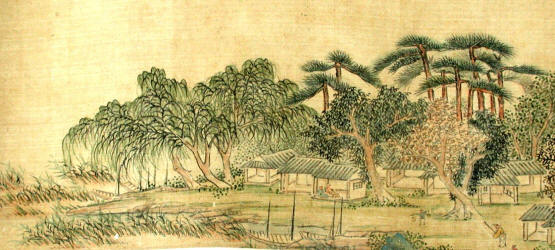|
Part Two: A Pleasant
Journey, Another Resting Place with Distant Views, or Three
Friends on a Rock
“Birds fly in great sky
circle of freedom.
How do they learn this?
They fall…
And having fallen, they
are given wings.”
Rumi, 13th
century Islamic poet
Where are we? We have unrolled the scroll to what
will be called, “Part Two,” a view of a scene where two
friends become three friends on a rock and we learn the
sadness of departure.

Orientation: One of the problems of going on a
journey is that love gets in the way of reason. I have
studied this scroll, lovingly unwinding it for my friends
for thirty-three years, and although I know that “Love is
blind” I keep alive my myth that “each time I take this
journey it is the first time” and I can objectively see it.
Since I know how love controls the eyes of the lover, I want
my fellow travelers to know this about their guide.
On the other hand, an experiment was tried with gamblers.
They had four decks to play with, two red and two blue, and
they were asked to play and make the most money that they
could. The decks were stacked so that anyone must use the
blue deck to make money. At about the fiftieth card chosen,
most people began to lean toward the blue decks of cards and
not choose from the reds; at the eightieth cards almost all
the players could tell why they choose the right deck. The
experienced gamblers started to lean toward the blue deck at
the tenth card but they did not know that they did it, could
not tell how they did it, except the palms of their hands
began to sweat. These experienced travelers of cards were
thin slicing the experience. They were taking little slices
of the information given and making unconscious decisions.
That is “thin slicing." If something is complex where you
cannot deal with all the information, the experienced
traveler takes only slices, uses his or her wealth of
knowledge and experience and comes up with a course of
attitude, feeling, thought and action (even when the
decisions are locked behind the closed door of the
unconscious).
This action of coming to the correct, but unconscious
choices, is normally true except when love or hate or any
other deeply-felt emotion gets in the way of our natural
flow of life. To use the metaphor of traveling on a lake, it
is like putting up a dam to what is happening around you so
that your observations (your path) cannot gently navigate
with the nature-made course of the slow-moving water.
Story: One day in Micronesia, just off the island of
Palau, I was taken out into the ocean so that I could not
see land. As a Westerner, I was totally lost but my guide, a
Palauan and navigator with vast experience, asked me: “Can you
feel that bump? We just passed the five mile reef.” I could
not but I tried and I had more confidence that he would not
get us lost. Later I did ask: “Which direction is Airai (the
island that we came from)?” He smiled and replied, “Can you
not see the reflection of the green in the cloud up there?
It is a reflection of the island's green. He pointed and, after a while, comparing that cloud to all
the others in the sky, I did see a hint of green." If my mind
was set that all clouds are white in the sunshine and darker
in a storm, I would not have been able to see that shade of
green. At night, my navigator could read the stars to get
back home to his island. These men create bamboo charts that
show the patterns of waves around an island so that they can
see these when they travel the Pacific. The Palauans have a
tradition of being the guides of the Pacific Ocean. In their
stories, they still guide strangers to populate Hawaii, the
Marshall Islands, Tahiti, and many more remote places across
the seas.
So it is with this journey! I have looked at this scroll over 300 times in those 33 years of “owning” the scroll but
also in that time, I have learned to love it. It is like a
marriage. We many times see our spouse with young eyes
(which is not bad but it is also not always the truth). As a
longtime Rotarian, the club’s question, “Is it the truth?”,
makes me wonder, “Which truth? The truth of youth revisited,
the truth of age wrapped in experience, or both tied
together as Freud might weave our fabric?” At times, we need
to take the hand of someone with us where this is their
first viewing or is just beginning to see (a child) so that,
if the emperor is not wearing cloths, he or she tells us the
obvious (no thin slicing needed there). Warren Buffet thin
sliced a truth when he observed: “You can’t tell if a man is
naked until the tide goes out.” To love something is good. I
never wish to lose that ability. But at times, love must be
wedded to reasoned observation.
 As your guide, I will show you my love but also I will be
the experienced adventurer and point out why I have come to
love certain experiences. As was said at the beginning, this
is a peaceful journey and peace is not a place. It is
centering your self in love and reason, allowing each to
inform you and help you to grow. As your guide, I will show you my love but also I will be
the experienced adventurer and point out why I have come to
love certain experiences. As was said at the beginning, this
is a peaceful journey and peace is not a place. It is
centering your self in love and reason, allowing each to
inform you and help you to grow.
I love this scroll and the messages of fellowship, learning,
mystery, surprise and wonder that it holds; therefore I never
had the title on the outside translated. But also, I do not
read the titles under paintings in the museums of the world
until I thoroughly digest the magic in the work of art. In
this case, it has taken me 33 years to begin to digest the
meanings in this special scroll. Therefore if anyone viewing
this has the scholarship to translate the writing on the
outside of the scroll, I may be ready. Send me a
translation. [Editor,
a translation was sent to our website and can be found at
this link]
Since this is a Ming Dynasty scroll, we are in for surprises
and surprises make us adjust to the new circumstances. But
that will come later, for now: stop with me and see what is
presently around us. Unwind with me the scroll to the second
viewing.
Let’s Thin Slice this New Experience: What do we see
here?

The gently rolling hills and mountains are behind us as
is ABA in an obvious formal arrangement. This is “new."
Two “pyramids” of composition are before us, each
mirroring the other. It is a “my-brother-he” landscape.
Two “friends” are now three, sitting on a rock at the
pinnacle of the main pyramid.
Isolated “boats” take us along our course in the “lake."
“Willows” and bulrushes symbolize departure and
“sadness."
In the background, “mists and walled fortresses” are
introduced for our viewing and speculation.
Rule Two: Make sure to
separate love and reason, but do not lose them.
As my first duty as your guide, I must tell you the scope of
my loves. Here is a running list: I love- to travel, to
watch, to visit, to experience, to live, to enjoy, to
virtually fly, to be surprised, to be challenged, to learn,
to share, to have fun, to reflect, to build, to create, to
search, to lead, to follow, to hug, to collect, to educate,
to breath, to discover…. and this is but a beginning list
from the conscious mind. As you move along on this journey,
ask yourself what you love and if it shapes how you see the
world. The vehicle of perception is ourselves and that
shapes the gestalt (those forms we choose to see) of what
reality presents to each of us. We can, once we have made a
list of our loves, add divisions to them: such as, to travel
inside and outward, to be surprised by shock or ah ha, to
create ourselves and works of art in the world. The 13th
century Islamic poet and mystic Rumi said, “May the beauty
we love be what we do.” Martha Graham, the innovative dancer and
choreographer, lived by the credo: “I am only in competition
with that person I know I can become.” Joseph Campbell, the
great “unraveler” of myth and legend, told his students and
anyone who would listen, “Follow your bliss.”
View the composition.
Here, as we enter the second viewing of the
scroll, we see a land mass in the shape of a pyramid and two
perspective lines of trees pulling our eye to the top of the
page. The two lines, unlike Renaissance lines of perspective
leading us into a distant view, lead us to a space in the
world, a void that we must fill with our imaginations.
Three viewers sitting on a
Rock: At the pinnacle of the land mass in the
foreground sit three friends on a rock viewing the distant
scene.

The rock is not a passive seat but aggressively slants as a
diagonal force into the void.
Story: In 1966, while studying Chinese painting at
the Palace Museum in Taipei, Taiwan, the other
Fulbright-Hays Scholars and myself went on a cross-island
adventure in a bus, stopping eventually in a small town
called I-Lan. That night, after being with fellow scholars
and travelers all day, jammed together in our mode of
travel, I had to be alone so I wandered off in search of
something interesting. I came to a river. I knew that it was
a river because I heard it rushing far below in the
small valley. By the faintest light of the moon which played
hide and seek with the clouds, I could make out a rope foot
bridge leading to the silhouette of a pagoda in the distance, on the far shore. At that instance, I knew that I
had to explore that pagoda so I held the side ropes, walked
over the boards held in place with firmly-tied knots (I
hoped), and began to walk in the air above the raging waters
far below. Fear hit me as I was two-thirds of the way across
so the remaining one-third was hard but not impossible. I
enjoyed the pagoda but then had to return. It had gotten
darker and it only hit me then, “You have to return by that
same rope foot bridge.” I said to myself, “Self, you did it
once. You can do it again.” But the night was darker and I
knew the terror that the trip would hold. I was blind in
this blackness. I groped the rope tightly with both hands
and started. This time, I only made it a little way before
the terror engulfed me, with the sound of the water below
and the cape of night holding me close. I stopped, knowing
that a return to the pagoda meant staying all night and also
knowing that I might not find another way across the river
in these mountains. With one hand still on the side rope and
one groping the boards under me, I crawled the rest of way.
At some time in that crawl, the river raging below became a
friend on my journey, the night was something that I could
wear with dignity and I could distance myself from this
creature crawling. I saw in a special light the whole scene
from above. I could center myself by distancing myself from
what I had to do. In that center was peace, not terror.
As your guide on this gentle trip in the light of day, I
still advise you to center yourself and to distance yourself
from that center so that we can view what you will see. The
first is a state of peace to go on a peaceful voyage across
this lake; the second, distancing yourself, is a fundamental
state for reasoned observations. Both, you should pack for
the trip.
You can see these two
companions, centering and distancing, as one to join with
you and your friend who started this trip. Two becomes three
(or four).
You may view these new friends as shelters, places to
reflect. In this scroll, the artist will give you different
kinds of shelters: a place where one person can sit and
meditate, a place in the open for two friends (one cut in
two at the bottom, by the restoration of the scroll) to view
a farmer hoeing his small garden, a house for two friends
with a repeat of two masts below, a boat in the lake with
two masts and three friends, and above the land stands one
majestic Evergreen thrusting its vitality into the space of
the lake with three groups of clustered green needles
overhead.

There are other clues to this bonding and metamorphosis of
twos and threes. As our sight journey starts at the right
side of this unwinding of the scroll, we see first one
lightly painted stone isolated, then two light ones (one
over the other) and then three light stones (repeated in a
vertical rhythm). It is as if the artist is showing us the
notes of his lake song. We know about the two and the three
friends but the one is still UNKNOWN.
It is time to rest a little, notice the distances between
each boat on the water, notice the steadfastness of the
friendship of the green of the Evergreens, notice the void
above us at the juncture of the two lines of tree, and just
enjoy (with me it is pure love) the brushwork, crude with
sophisticated meanings. Each brushstroke has a life of its
own: a beginning where the brush first caresses the page
after the ink is created, a duration or journey as the brush
moves along the space and finally a termination, an ending
with a flurish.
Rule Three: Stop and watch
the trees grow, the sun shine, the water forming the land,
and the elements of surprise. You might learn something
about the nature of peaceful journeys.

Some new things introduced: move your eye to the
background where the mists and walled fortresses first
appear.
In the Chinese paintings that I have studied at the Palace
and other museums, the mists are: 1) sometimes devices to
allow you to use your imagination and 2) symbols of the
unknown (and sometimes, the unknowable). In this second
viewing, we see the mists gathering around walled fortresses
in the distance. The walled fortresses may be embodiments of
each of us walling ourselves in against new experiences, new
information and new ideas. We are safe but are we truly
alive? You can be safe, centered and distant, while still
being wholly in an experience.
Each individual on this journey should ask, at some point in
the experience, if being safe is the meaning of the voyage,
if risk is not the element that keeps life growing and
alive. The green freshness of our friends on this trip will
help to keep us safe and peace will be what we journey with
and find at the end of this sojourn. Ask yourself, am I the
walled fortress or do I embrace the mist as a tool and a
companion?

Departure and loss: As we near the end of this second
part of our journey, we find that leaving a place that we
have lived, explored and come to know (maybe love) there is
a sadness with our departure. Symbols for this sadness are
the weeping willows and the leaning bulrushes. The bulrushes
bend toward the future and away from the past. Some
scientific minds would say that they bend toward the living
water and away from the dry land. In human terms, this
brings up the emotions of moving on, leaving something dear,
and not knowing what the next unwinding of the scroll will
bring.

A Look Back: Review Where We Have Been: What is
marvelous about a handscroll is that as you unwind in one
direction, if you wish to see where you have been, you can
rewind the scroll back to those scenes.
 |

